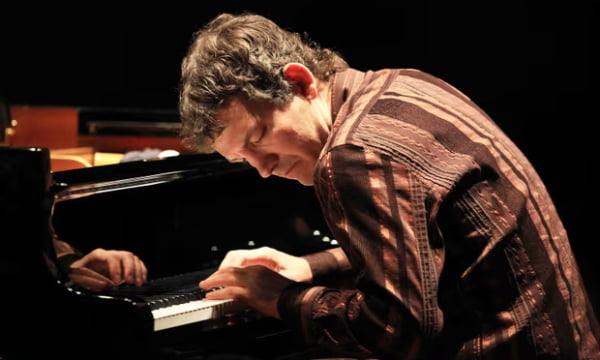The Sinopoli Hall was reserved for the Mehldau trio: it is the one in which the Orchestra of the Accademia di S. Cecilia usually plays, the detail is more significant than ever.
This environment equipped with all the latest discoveries in acoustic technology is full to the last place: further wonder, Brad is a leading figure in contemporary jazz, but seeing over 1,100 people gathered for him makes a notable impression on those like me who are used to to the miserable life of the Milanese scene. Brad’s people are extremely varied, especially in terms of age, there are quite a few twenty- and thirty-year-olds: at first glance it seems like a nice audience that is not only cultured, but also quite passionate, as the rest of the evening will confirm.
The stage trio is new to our latitudes: alongside Mehldau on piano we see Jorge Rossy on drums and above all Felix Moseholm on bass (obviously acoustic). If the drummer is a well-known figure, Moseholm arouses more curiosity: he is a Danish musician, who in a previous musical life frequented Bach on the cello (a very revealing precedent), before diving headlong into the New York jazz scene where he filled his 27 years of a remarkable and extremely varied series of experiences. Mehldau was keen to point out that he has been playing with Moseholm for almost four years. In short, we are not faced with an occasional lineup, far from it.
It’s been a long time since we have recorded evidence of Mehldau in a trio, a formation within which ours has now created a real canon: the first approach to the new combo is quite surprising even for those who have met the pianist several times.
https://youtu.be/f-8jGkyakXg
In fact, Mehldau proposes a pianism reduced to the essential, highly internalized and concentrated. His hands almost never move away from the central octaves of the keyboard: there is a deliberate renunciation of the play of marked dynamic contrasts and saturated and dense colors. The comparison with watercolor is immediate, a pictorial technique which, alongside soft and transparent colours, requires absolute clarity and precision of the underlying drawing. One might think that much of the Bach that he frequented for his latest recordings remained in his hands and in his head.
The repertoire choices are based in large part on his old songs, however filtered by this new restrained and nervous attitude. However, some modern standards also stand out and struck me.
Estate’ by Bruno Martino is not a gesture of complacency towards the Italian public, the sober and laconic Brad is a thousand miles away from the pleasure of a certain ‘cruise pianism’ that circulates in our area. This is the only Italian song present in the Real Book, and what’s more it is the choice of choice especially for refined and intense pianists such as Roger Kellaway or Michel Petrucciani. They believe it, period. Mehldau’s version aimed to bring out a subtle vein of bossa nova, but the exposition of the theme and the beginning of the development were harassed by the usual idiot who did not silence his cell phone, whose ringtone delighted us until its exited the room (slamming the door….).
With others on stage this episode could have degenerated into a real catastrophe, but fortunately there were real jazz musicians on stage: Rossy promptly integrated the ringtone into her rhythm, commenting with an ironic “Wow, it works!’. General laughter, this is also improvisation
Moseholm was expected: he deliberately sacrificed the fullness of the sound and its darker colors to obtain a more agile and nervous phrasing, capable of following Brad’s uninterrupted and airy flow of ideas. A happy choice, the bassist is fully integrated into the group’s physiognomy: let’s add Rossy’s light drumming, almost always based on the three cymbals except for a few slightly more marked breaks on the drums, and we have a group image that tends towards what the French would call the ‘clartè’.

Rigorous lucidity and precision that do not exclude passion, clearly perceived by a splendid audience, who also participated by commenting with subdued murmurs of approval on the repertoire choices diligently announced from time to time by the pianist. Who at a certain point failed to display his impeccable aplomb, addressing the audience with a sudden “I feel so much energy coming from you”
That it wasn’t a phrase of circumstance was seen at the end of the concert, greeted by an ovation as oceanic as the Sala Sinopoli. An encore follows, ‘Up on a hill’, I think, and so far we are in the ritual of a concert. At the end, however, ovation no. 2 starts, complete with shouts of acclamation: the trio goes back on stage, a meeting follows, and a ‘Nobody else but me’ starts, clearly improvised on the spot. After ten minutes of a standard revisited with lively relaxation, ovation no. 3 starts, even more intense than the other two. After a couple of minutes, the trio reappears on stage and a perceptibly emotional Mehldau surprisingly announces ‘Annabella’ by Nat King Cole, another 7 minutes of music. At the end, yet another oceanic cheer: knowing Mehldau I would bet that he was already thinking of a fourth encore, when Moseholm resolutely turns off his bass amplifier. After more than 90 minutes of music, a truly memorable evening ends, in which we saw at work what I would indicate at first glance as the exemplary jazzman, the one who today exemplifies in himself the deepest DNA of this elusive music according to of the most.
This Roman evening makes us feel the prolonged lack of trio recordings by Mehldau, who recently gave us records in which he appeared above all as a composer for quite unusual and original ensembles and materials. ‘Live in Rome, Parco della Musica’ could have been a splendid album…. But regrets have no right to citizenship in jazz.
https://youtu.be/zZc7dfqDgmg

